JEE Advanced (One or More Correct Option): Current Electricity | Chapter-wise Tests for JEE Main & Advanced PDF Download
Q.1. In the circuit shown in the figure: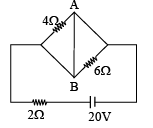 (a) power supplied by the battery is 200 watt
(a) power supplied by the battery is 200 watt
(b) current flowing in the circuit is 5 A
(c) potential difference across 4 resistance is equal to the potential difference across 6W resistance
(d) current in wire AB is zero
Correct Answer is option (a, c)
4Ω and 6Ω resistances are short circuited. Therefore, no current will flow through these two resistances. Current passing through the battery is I = (20/2) = 10A.
This is also the current passing in wire AB from B to A.
Power supplied by the battery
P = EI = (20)(10) = 200 Watt
Potential difference across 4 Ω resistance
= Potential difference across 6Ω resistance = 0
Q.2. R = 10Ω & E = 13 V and voltmeter & Ammeter are ideal then -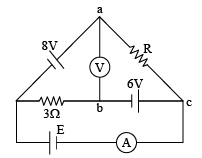 (a) Reading of Ammeter is 2.4 A
(a) Reading of Ammeter is 2.4 A
(b) Reading of Ammeter is 8.4 A
(c) Reading of voltmeter is 8.4 V
(d) Reading of voltmeter is 27 V
Correct Answer is option (b, d)
Using Kirchoff's Law Solve the circuit.
Q.3. Four identical bulbs A, B, C, D are connected in a circuit as shown in figure. Now whenever any bulb fails, then it cannot conduct current through it. Then –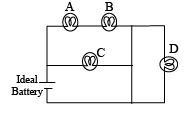 (a) Brightness of bulb C is highest
(a) Brightness of bulb C is highest
(b) If C fails, brightness of bulb D increases
(c) If C fails, brightness of all bulbs remain same
(d) If A fails, B will not glow
Correct Answer is option (a, c, d)
Potential difference across D is zero so it will not glow at all.
Potential across C is maximum.
∴ It will glow maximum and if C fuses then also potential across each bulb will remain same.
Brightness of each bulb will remain same.
Q.4. Each resistance in the circuit is of 1Ω. Current of 1A flows through the last resistance as shown in figure. Then - (a) v is 21 volt
(a) v is 21 volt
(b) total current (i) through battery is 21 amp
(c) V is 34 volt
(d) equivalent resistance is 1.62 W
Correct Answer is option (b, c, d)
V = 21 × 1 + 13 × 1 = 34 volt
Total current through battery is 21A
Req = I/V
= 34/21 = 1.619Ω = 1.62Ω
Q.5. For the circuit shown in figure, which of the following statements are correct ?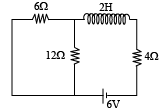 (a) Its time constant is 0.25 sec
(a) Its time constant is 0.25 sec
(b) In steady state, current through inductance will be equal to zero.
(c) In steady state, current through the battery will be equal to 0.75 amp.
(d) None of the above
Correct Answer is option (a, c)
6Ω and 12Ω are in parallel
Time constant = L/R = 2/8 = 8 0.25 sec
In steady state inductor behave as conducting as conducting wire.
∴ i = 6/8 = 0.75 amp
Option (C) is correct.
Q.6. For the circuit shown in Fig, which of the following statement is/are correct?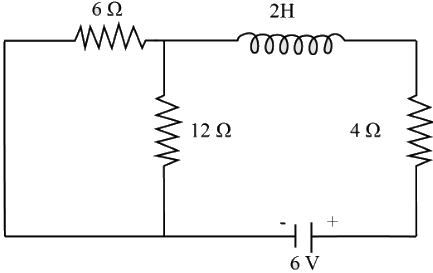
(a) Its time constant is 0.25 s
(b) In steady state, current through the inductance will be equal to zero.
(c) In steady state, current through the battery will be equal to 0.75 A.
(d) None of these.
Correct Answer is option (a, c)
Time constant τ = L/Req
For,
For Req
Assuming inductor to be a connecting wire,
The two resistors of 6Ω and 12Ω are in parallel and the combination is in series with 4Ω
∴ Req = 8Ω
τ = 0.25 s
In steady state, inductor acts as a short.
In steady state, current through battery = 6/8 = 0.75A
Q.7. When a potential difference is applied across, the current passing through
(a) an insulator at 0 K is zero
(b) a semiconductor at 0 K is zero
(c) a metal at 0 K is finite
(d) a p-n diode at 300K is finite, if it is reverse biased
Correct Answer is option (a, b, d)
At 0 K an insulator does not permit any current to flow through it. Option (a) is correct.
At 0 K a semiconductor behaves as an insulator. Option (b) is correct.
In reverse biasing at 300 K, a very small current. flows through a p-n junction diode. Option (d) is correct.
In case of metal, the current flowing will be very-very high because a metal becomes super conductor at 0 K. Option (c) is incorrect.
Q.8. An incandescent bulb has a thin filament of tungsten that is heated to high temperature by passing an electric current. The hot filament emits black-body radiation. The filament is observed to break up at random locations after a sufficiently long time of operation due to non-uniform evaporation of tungsten from the filament. If the bulb is powered at constant voltage, which of the following statement(s) is(are) true?
(a) The temperature distribution over the filament is uniform
(b) The resistance over small sections of the filament decreases with time
(c) The filament emits more light at higher band of frequencies before it breaks up
(d) The filament consumes less electrical power towards the end of the life of the bulb
Correct Answer is option (c, d)
With the use of filament and the evaporation involved, the filament will become thinner thereby decreasing the area of cross-section and increasing the resistance. Therefore the filament will consume less power towards the end of life. As the evaporation is non-uniform, the area of cross-section will be different at different cross-section. Therefore temperature distribution will be non-uniform. The filament will break at the point where the temperature is maximum.
When the fillunent temperature is higherit emits light of lower wavelength or higher band of frequencies.
Q.9. Two bulbs A and B consume same power P when operated at voltages V1 and V2 respectively. If these bulbs are connected in series across a DC source, then:
(a) ratio of potential differences across A and B will be equal to V1 : V2
(b) ratio of potential differences across A and B will be equal to V12 : V22
(c) ratio of power consumed in A and B will be equal to V12 : V22
(d) ratio of power consumed in A and B will be equal
Correct Answer is option (b, c)
If a bulb having resistance R is used across a voltage V, power consumed in it is given by
Hence, resistances of two bulbs are:
If these bulbs are connected in series, the current through them will be same. Hence, potential differences across them will be proportional to their resistances. Therefore, the ratio of potential differences across them will be equal to R1 : R2 = V12 : V22.
Hence. The option (A) is wrong but the option (B) is correct.
Powers consumed in them will be equal to P1 = i2R1 and P2 = i2R2
Since, same current flows through the bulbs, therefore, P1 : P2 = R1 : R2 = V12 : V22
Hence, the option (C) is correct but the option (D) is wrong.
Q.10. For the circuit shown in figure, choose then correct options: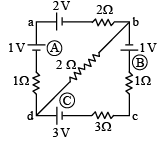
(a) The current in db is 1/13 amp
(b) The PD across db is 2/13 volt
(c) The PD across the cell (C) is 21/13 volt
(d) The PD across the cell (B) is 19/13 volt
Correct Answer is option (c, d)
From the loop badb, 2i1 – 2 + 1+ i1 + 2(i1 – i2) = 0
5i1 – 2i2 = 1 ......(1)
From the loop dcbd, – 3 + 3i2 + i2 + 1 – 2(i1 – i2) = 0
or, – 2i1 + 6i2 = 2 ......(2)
From eqs. (1) and (2),
So, i1 – i2 = 1/13 amp
∴ Vb - Vd = 2/13 voltThe PD across the cell (C) is:
Vc – Vd = – 3i2 + 3 = 21/13 volt
The PD across the cell (B) is:
Vc – Vb = i2 + 1 = 19/13 volt
|
446 docs|929 tests
|





















